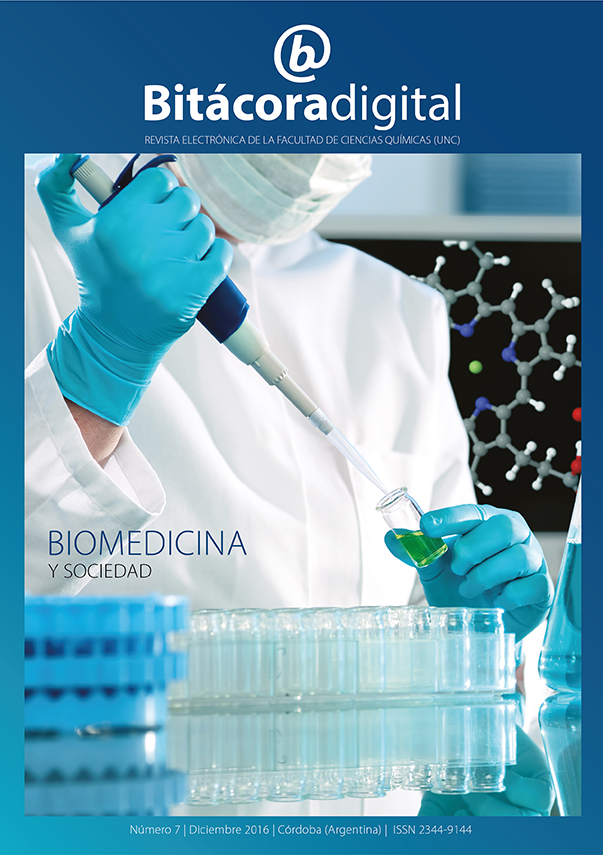Nanomedicina y Sociedad: Nanopartículas biodegradables aplicadas a Diagnóstico y liberación controlada de fármacos - Nanomedicine and Society: Biodegradables Nanoparticles applied to Diagnostics and controlled drug delivery of Pharmaceutical drugs
Abstract
Resumen: Los fármacos son ampliamente utilizados en diferentes formulaciones y dosificaciones según la enfermedad. El desarrollo de Nanoestructuras biodegradables en la biomedicina ha permitido solucionar problemas presentes en la utilización de fármacos convencionales microparticulados. Su biodisponibilidad puede ser incrementada permitiendo mejorar la dosificación, prolongar el efecto terapéutico, disminuir las reacciones adversas. Su especificidad es incrementada mediante la incorporación de biomoléculas y de anticuerpos permitiendo de esta manera aumentar la concentración local del fármaco. Además, es posible acoplar tratamientos complementarios para una mayor efectividad.
La química supramolecular, basada en enlaces no covalentes, y la química de polímeros permiten la obtención de Nanoestructuras con diversas propiedades. Además, materiales orgánicos híbridos en presencia de Nanopartículas inorgánicas adquieren propiedades metálicas, magnéticas, conductoras, plasmónicas, etc.. De dichos materiales aparecen nuevos conceptos de diseños tal como Nanopartículas con corazón metálico recubiertas con espaciadores moleculares, poliméricos, conteniendo drogas de interés farmacéutico, sobre las cuales se le adicionan biomoléculas, anticuerpos, etc. de manera de conferirles especificidad.
Por último es importante mencionar que además de las aplicaciones de liberación controlada, dichas estructuras tienen diversas aplicaciones tal como detección de eventos biológicos, detección y seguimiento de células, diagnóstico por imágenes y nuevas terapias en Nanomedicina que aportan grandes perspectivas futuras en el mercado farmacéutico.
En el presente artículo se presentan resultados obtenidos en la síntesis de diferentes Nanoparticulas con aplicación en diagnóstico y Nanomedicina.
Abstract:
Pharmaceutical drugs are highly used in different formulation and dosifications depending of the health problem. The development of biodegradable Nanostructures in biomedicine allows to find solutions to present problems for the application, dosing and controlled treatments with microparticulatedpharmacophores. The bioavailability could increase allowing improve the dosification, improving the therapeutic effect and diminishing adverse reactions. The specificity is enhanced, by increasing with incorporation of biomolecules and antibodies, and by this manner the local pharmacophore concentration is increased. These Biodegradable Nanostructures could be coupled to other treatments for an enhanced effectivity.
The Nanostructures can be obtained by many chemical structures. From the Supramolecular Chemistry based on non-covalent interactions and polymer chemistry it could be synthesized Supramolecular Nanoparticles and Nanoaggregates with applications in a new field named SupramolecularNanomedicine. Moreover, in presence of Hybrids Materials from the combination of organic materials and inorganic Nanoparticles it could be obtained Nanomaterials with additional properties as metallic, magnetics, conductors, plasmonics, etc., that in combination with organic materials give as result a multifunctional structure. From this concepts new structures as core-shell Nanoparticles, with polymeric and molecular spacers loaded with fluorophores and pharmacophores, can be used as platforms for targeting of biological structures. It is important that the new trends of developments shows that these Nanostructures are applied not only to drug delivery, but also to Diagnostics and NanoImaging developing new therapies based on Nanomedicine.
In the present Article is presented results in the different topics mentioned in this interdisciplinary field that it is Diagnostics and Nanomedicine.
Downloads
Published
Issue
Section
License
Licencia Creative Commons BY NC
Usted es libre de:
- Compartir — copiar y redistribuir el material en cualquier medio o formato
- Adaptar — remezclar, transformar y construir a partir del material
- La licenciante no puede revocar estas libertades en tanto usted siga los términos de la licencia
Bajo los siguientes términos:
-
Atribución — Usted debe dar crédito de manera adecuada, brindar un enlace a la licencia, e indicar si se han realizado cambios. Puede hacerlo en cualquier forma razonable, pero no de forma tal que sugiera que usted o su uso tienen el apoyo de la licenciante.
-
NoComercial — Usted no puede hacer uso del material con propósitos comerciales.

